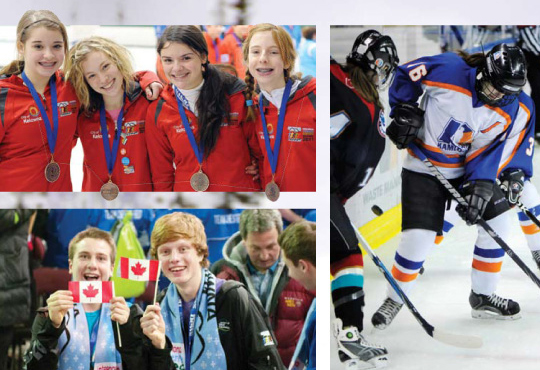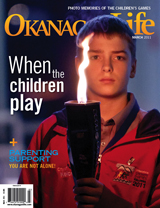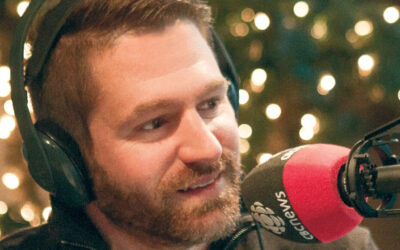 Central Okanagan shooters seize the opportunity to stretch their photographic skills and capture some unforgettable moments in the young careers of what may prove to be tomorrow’s Olympic heroes. Concentration is etched on the faces of skaters taking in last minute instructions from their coaches as they prepare for one final practice at the International Children’s Games in Kelowna. Competition now just hours away, their every move is captured by the panning lenses of a group of amateur photographers who have volunteered to record the games. Cameras gripped between gloved hands, members of the Central Okanagan Photographic Society (COPS) are out in force. They’ve got a lot of territory to cover in the Jan. 26 to 31, 2011, event.
Central Okanagan shooters seize the opportunity to stretch their photographic skills and capture some unforgettable moments in the young careers of what may prove to be tomorrow’s Olympic heroes. Concentration is etched on the faces of skaters taking in last minute instructions from their coaches as they prepare for one final practice at the International Children’s Games in Kelowna. Competition now just hours away, their every move is captured by the panning lenses of a group of amateur photographers who have volunteered to record the games. Cameras gripped between gloved hands, members of the Central Okanagan Photographic Society (COPS) are out in force. They’ve got a lot of territory to cover in the Jan. 26 to 31, 2011, event.
A total of 472 athletes aged 12 to 15, representing 37 cities and 13 countries, were in Kelowna to compete in figure and speed skating, alpine and Nordic skiing, snowboarding, curling and hockey.
When COPS vice-president Jim Harding learned the games were coming to town he thought it would be a great opportunity for members to shoot some sports. It was also another chance to give back to the community. Over the years members have volunteered their time and photographic skills to such events as the MS Walk, Variety’s Boat for Hope, Help-Portrait and the 1995 Special Olympics Winter Games.
The organization got its official start in 1973 but there are records of a camera club in Kelowna dating as far back as 1960. Formed by avid shutterbugs, the purpose of the club has always been to get together to share an interest in photography and improve individual skills.
All ages and skill levels are welcome and you don’t need a fancy camera to join the society, although there is always a bit of friendly rivalry between Canon and Nikon owners. Inevitably, the first question guest presenters are asked is what kind of camera they use.
Meetings, which are held weekly from September through May, feature guest speakers, educational talks and photo evaluations. Field trips and workshops provide members with a chance to get together, shoot and pick up new tricks.
A significant amount of preparation went into the games including officially registering as volunteers and attending orientation. A total of 16 members took part, a mix of amateurs and seasoned veterans. Avid sports photographer Carl Dubeau was kept busy fielding questions and he delivered a special presentation at one meeting. Hockey fan Tom Witt contributed written instructions on photographing hockey.
When it was finally show time, volunteers armed with shooting tips and long lenses (spare batteries tucked close to their bodies) headed out to their assigned venues. Jim organized the photographers based on individual availability and preferred sporting events.
“Towards end, I felt like an one armed quarterback,” he says. When someone phoned in sick he found a replacement. When the games office called looking for coverage, Jim got on the horn and dispatched a photographer. Members covered every event including airport arrivals, opening and closing ceremonies, Mayor’s reception, fun night at the H2O Centre and skating gala.
“The club and group of photographers were outstanding,” says games communications chair Eric Stansfield. “As the old saying goes, a picture is worth a thousand words. All the photographers captured the true essence of the games.”
The event produced some great stories like the curling team from Chesterfield in the United States, that three weeks prior to the games had never curled. Their first practice at home was on a hockey rink and with only three players the team had to borrow a curler from Kelowna. How’s that for the spirit of sport. Then there was the boys’ hockey team from Darmstadt, Germany, who had the youngest players (12 to 13 year olds) and took a beating on the scoreboard but never gave up.
Eight-hundred and ninety volunteers signed on to take care of the athletes, from feeding to transportation to working at the various venues of Memorial, Rutland and CNC arenas, Kelowna Curling Club, Telemark and Big White.
Although the games were not about breaking records and podium finishes, the top three in each event were awarded medals. Seoul, Korea, took home the most bobbles with 11 (six gold and five silver); followed by Gorje, Slovenia (six gold and four silver), and Kelowna (two gold, three silver and five bronze). But COPS came out way ahead in the numbers game with thousands of irreplaceable photos. —Karen Slivar
Photos by members of the Central Okanagan Photographic Society (COPS)




0 Comments